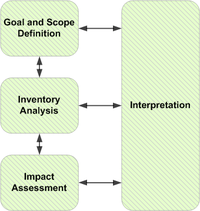
Photo from wikipedia
Though the partitioning behavior of organophosphorus flame retardants (OPFRs) has been recognized in in vitro incubation assay, health risk assessment on those internal exposure with or without partitioning indexes in… Click to show full abstract
Though the partitioning behavior of organophosphorus flame retardants (OPFRs) has been recognized in in vitro incubation assay, health risk assessment on those internal exposure with or without partitioning indexes in human blood is still unclear. In this study, nine commonly used OPFRs were quantified in 96 pairs of plasma and blood cell samples from Chinese volunteers. Non-carcinogenic and carcinogenic risk (CR) assessment building upon two distinct scenarios were conducted and compared. The dominant OPFRs in both plasma and blood cells were TBEP, TBP and TPHP. TCEP was the most enriched compound in plasma with Fplasma nearly to 1.0 (0.92), followed by TCPP, TBEP, TPHP, TBP and TEHP (from 0.61-0.76). The partitioning behavior of TCP in plasma was equivalent to blood cells with Fplasma at 0.50. When fully considered the Fplasma, the estimated average daily intake (DI) of ∑OPFRs (638.44 ng/kg BW/day) reached nearly 1.48-fold higher than the conventional calculation (dividing the concentration of plasma (Cplasma) by a factor of 2.0). Accordingly, we found the average hazard quotation (index) of TBP, TPHP and ∑OPFRs was underrated 1.50-fold when neglected the partitioning behaviors. Notably, the average CR of TCEP exceeded 10-6 at the highest concentration (1.19×10-6 ng/mL in plasma) only when the Fplasma was introduced. These data conjointly demonstrated that most of the DI levels and the corresponding risk index of OPFRs would be underestimated without factoring Fplasma into calculation, especially for those of low plasma partitioning. To our best knowledge, this study initially uncovered the gap between introducing Fplasma and dividing Cplasma by 2.0 during health risk assessment on internal OPFRs exposure.
Journal Title: Environmental research
Year Published: 2022
Link to full text (if available)
Share on Social Media: Sign Up to like & get
recommendations!